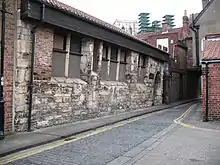Bedern
Bedern is a street in the city centre of York, in England, which originated as a college for the vicars choral of York Minster.

History
The Bedern College was founded in 1252, to house 36 vicars choral associated with York Minster. The name "Bedern" meant "house of prayer", and was in use by 1270. It was funded by three grants of land in Yorkshire, one in Hampshire, and the rents of 200 houses in York. It was built on land associated with somebody named Ulphus, which was donated by William of Laneham. The buildings consisted of small houses, a chapel, and a dining hall with kitchens, a buttery and a brewhouse, all built around a green. There was also a record room, and behind the buildings lay a garden and an orchard. In 1396, the site was improved by the construction of a latrine, and a bridge across Goodramgate, so that the vicars could enter the Minster close without crossing the public street.[1]
In 1574, the vicars stopped dining together, and from 1640, the dining hall was leased out. The college was dissolved during the Commonwealth of England, but reformed afterwards. There were aborted plans to establish a university in the college buildings, while from 1644 until 1730, St Peter's School occupied many of them. By 1700, only five of the houses were occupied by vicars, and during the following century, the houses were replaced by newer buildings, while the latrine was rebuilt as a stable.[1]
By the mid-19th century, the street was one of the poorest in the city. Its population had risen to more than 300, and it was largely occupied by recent Irish emigrants. In 1853, the street was extended to the south-east, to reach St Andrewgate. In 1883, the houses on the north-east side, three of which had Dutch gables, were demolished and replaced by the Ebor Buildings and Hawarden Place, but these in turn were demolished in the 1970s.[1]
Layout and architecture

The street runs south-east, from Goodramgate to St Andrewgate, accessed at each end via a passageway through a terrace. Bartle Garth joins its south-western side.[1]
Two buildings from the college survive: Bedern Hall, and Bedern Chapel.[1]
References
- An Inventory of the Historical Monuments in City of York, Volume 5, Central. London: HMSO. 1981. Retrieved 7 August 2020.